| Pages:
1
..
10
11
12
13
14
..
18 |
Raid
Hazard to Everyone
  
Posts: 202
Registered: 14-11-2022
Location: N/A
Member Is Offline
Mood: School
|
|
well if you live in America it would be F and yes its a very large anti-static bag, it fits my whole house inside.
|
|
|
Texium
Administrator
       
Posts: 4580
Registered: 11-1-2014
Location: Salt Lake City
Member Is Offline
Mood: PhD candidate!
|
|
This is an international science forum. Specifying units of temperature is important, and without specification it’s assumed to be Celsius by
default, ‘Murica or not.
|
|
|
Herr Haber
International Hazard
    
Posts: 1236
Registered: 29-1-2016
Member Is Offline
Mood: No Mood
|
|
@Bert
Well... I was wrong ! I left the small beaker for a few days and after settling I am left with a very light blue solution.
I used "a few" dragon eggs but certainly less than a gram which would amount *at most* to 150mg given your composition. Said composition doesnt
include the priming (black powder) on the eggs that seems to constitute most of the sediment (carbon).
The spirit of adventure was upon me. Having nitric acid and copper, I had only to learn what the words 'act upon' meant. - Ira Remsen
|
|
|
Fantasma4500
International Hazard
    
Posts: 1681
Registered: 12-12-2012
Location: Dysrope (aka europe)
Member Is Offline
Mood: dangerously practical
|
|
dragon eggs have practically zero brisance, poor predictor for it being useful for initiation
i have seen dragon eggs on youtube that were pretty big in size and seemingly went off by fuse right away without smoldering first
however the smoldering part i have seen with copper sulfate and copper oxide compositions where its first superheated and then loudly and sharply
explodes in open air, its possible to "charge" regular flashpowder by heating it up first as well
mixtures of our beloved sugar nitrate with primary-like binary mixes is more interesting, armstrongs mixture and sugar nitrate was found capable of
detonating but the guy who played around with it didnt bother finding a working ratio of stability and detonating in open air, he rather just put a
core of flashpowder sorrounded by the sugar nitrate
if you must, 10mm aluminium tube with 500mg of the sugar nitrate sealed in by 2 1mm aluminium foil discs, then a slowburning composition- such as
liptakovs caramelite and a fuse leading into this with some KClO3 sugar mix to carry ignition, secured with cotton wool goes well, appears that maybe
50mg of the nitrate burns off rapidly whereafter it goes high order, the aluminium tube does not at the bottom get hot enough to ignite
nitrocellulose- this means the tube doesnt get hotter than 120*C - essentially its safe to use in combustible charges without risking the charge
burning up before initiation goes
|
|
|
specialactivitieSK
Hazard to Self
 
Posts: 94
Registered: 21-10-2014
Member Is Offline
Mood: No Mood
|
|
Blasting cap protector
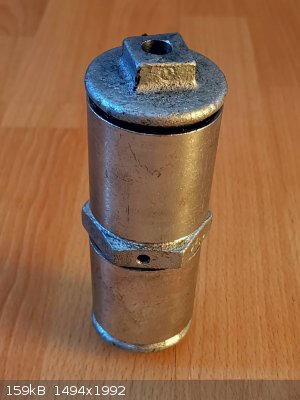
|
|
|
B(a)P
International Hazard
    
Posts: 1139
Registered: 29-9-2019
Member Is Offline
Mood: Festive
|
|
I would be interested to know more.
What does this actually do?
Is it to protect the user from an accidental detonation or the detonator from an accidental stimulus?
Without context it kind of just looks like a pipe bomb.
|
|
|
specialactivitieSK
Hazard to Self
 
Posts: 94
Registered: 21-10-2014
Member Is Offline
Mood: No Mood
|
|
protect the user from an accidental detonation
|
|
|
Microtek
National Hazard
   
Posts: 869
Registered: 23-9-2002
Member Is Offline
Mood: No Mood
|
|
Have you tried setting a detonator off inside it on purpose (and with proper safety measures)? A number 8 equivalent detonator really is quite
powerful...
|
|
|
Herr Haber
International Hazard
    
Posts: 1236
Registered: 29-1-2016
Member Is Offline
Mood: No Mood
|
|
Quote: Originally posted by Microtek  | | Have you tried setting a detonator off inside it on purpose (and with proper safety measures)? A number 8 equivalent detonator really is quite
powerful... |
When I thought about the construction of such a device I imagined it would probably be better to have a thick walled inner tube with a lot of holes
and an outer tube with less holes and kaowool in between all welded on a round plate and screw top on the other end
I realize that looks like a bulky sound supressor.
The spirit of adventure was upon me. Having nitric acid and copper, I had only to learn what the words 'act upon' meant. - Ira Remsen
|
|
|
dettoo456
Hazard to Others
  
Posts: 242
Registered: 12-9-2021
Member Is Offline
|
|
Haber, a suppressor-like design that has some sort of baffles (facing the center of the cylinder rather than perpendicular like for a firearm) might
work to break up small enough blastwaves for <1g amounts of EM. Although I think at that scale, the blast wave is less important to minimize than
the shrapnel. If it’s possible to use a fiberglass insulated, kevlar or weaved carbon tube (wrapped around the long edge of the cylinder), the
shrapnel and blast wave of an accidental detonation could be ‘caught’ by the threads of composite fiber (kevlar, carbon fiber, etc).
If you are trying to construct a magazine for bulk storage of EM though, with no shrapnel/metal casings involved, a setup incorporating big spikes
(like sound deafening foam but made out of wood or some other compressible material) and baffles might be a good way to break up or at least slow down
a blast wave before it can break out of the magazine walls.
Never store EM in a non-compressible material environment.
|
|
|
B(a)P
International Hazard
    
Posts: 1139
Registered: 29-9-2019
Member Is Offline
Mood: Festive
|
|
Quote: Originally posted by Microtek  | | Have you tried setting a detonator off inside it on purpose (and with proper safety measures)? A number 8 equivalent detonator really is quite
powerful... |
Plus one to this.
How is it constructed, what are the materials?
Do you have a photo of the internals?
|
|
|
ManyInterests
National Hazard
   
Posts: 930
Registered: 19-5-2019
Member Is Offline
|
|
A while ago I made blasting caps using plastic pen bodies, but I have a feeling that the hardness of the plastic might have been the thing that was
interfering with the explosive train. I remember once thinking about making blasting caps out of cardboard, but I never found a suitable tube for it.
I did, however, get some large paper straws (the type people use to drink bubble tea) and the larger diameter would make things easier for loading and
pressing. But I also think that military caps made using cardboard bodies (such as Soviet detonators during WW2) had similar strength. Obviously some
waterproofing would be needed, or at least wrapping them in electrical tape should do the trick.
I made a pair with CHP, albeit I didn't do more than hand pressing since I am still to scared to try to use my C-clamp to press harder on the stuff. I
will need a better setup for it as well.
I want to try to see if I can meltcast ETN in a waterproofed paper cap. I sealed the end with 5-minute epoxy and I do believe that the melting point
of epoxy resin is easily over 100C, so no need to worry about the plug melting on that end.
|
|
|
ManyInterests
National Hazard
   
Posts: 930
Registered: 19-5-2019
Member Is Offline
|
|
So around two weeks ago I wanted to go out to a location I went to previously and test out my caps with a proper steel witness plate (pictured below)
but sadly the weather was not what I anticipated. It was raining HARD, so I had to cancel my trip.
I once did ask how I would put my caps without gluing them on a metal plate, but I did find the following at a local hardware store (they also have
the benefit of being dirt cheap). Would a cap taped to the side of the plate allow for proper force to be directed downward for a proper test to
happen?
I promise, this is the last question I will be asking about caps before I go out and finally blow some holes into metal and see how my caps work.
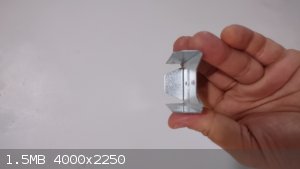 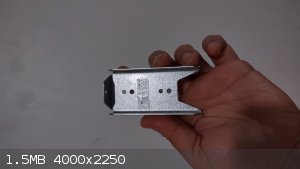 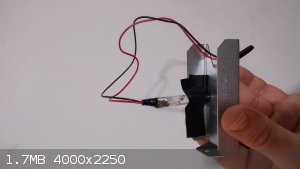 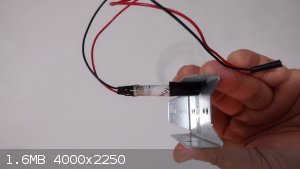
|
|
|
B(a)P
International Hazard
    
Posts: 1139
Registered: 29-9-2019
Member Is Offline
Mood: Festive
|
|
Tape will work fine as you have it. Best of luck with the weather for your next outing.
|
|
|
ManyInterests
National Hazard
   
Posts: 930
Registered: 19-5-2019
Member Is Offline
|
|
Thanks. Many of those caps were made last summer and I am itching to set them off. I also used the NHN/chlorate mixture that is covered in another
thread. I will also be trying straight NHN in a brass 5.56x45mm/.223 case and one of the 1.2g of ETN + 0.5 of straight ETN in a longer, but slightly
narrower, metal body.
That metal body you see appears to be ideal for most caps, since it is 8x50mm, given how loose the 6.35mm dowel that I used to press the stuff in
there was, I assume it is a 8mm OD but 7mm ID, which makes it a very good diameter for most caps.
|
|
|
OneEyedPyro
Hazard to Others
  
Posts: 280
Registered: 7-10-2015
Member Is Offline
Mood: No Mood
|
|
Quote: Originally posted by ManyInterests  | A while ago I made blasting caps using plastic pen bodies, but I have a feeling that the hardness of the plastic might have been the thing that was
interfering with the explosive train. I remember once thinking about making blasting caps out of cardboard, but I never found a suitable tube for it.
I did, however, get some large paper straws (the type people use to drink bubble tea) and the larger diameter would make things easier for loading and
pressing. But I also think that military caps made using cardboard bodies (such as Soviet detonators during WW2) had similar strength. Obviously some
waterproofing would be needed, or at least wrapping them in electrical tape should do the trick.
I made a pair with CHP, albeit I didn't do more than hand pressing since I am still to scared to try to use my C-clamp to press harder on the stuff. I
will need a better setup for it as well.
I want to try to see if I can meltcast ETN in a waterproofed paper cap. I sealed the end with 5-minute epoxy and I do believe that the melting point
of epoxy resin is easily over 100C, so no need to worry about the plug melting on that end. |
More strength and confinement with a cap body is generally what you'd want. A paper straw isn't an improvement by any stretch.
You can find lots of suitable tubes of varying sizes at a dollar store or the arts and crafts section in a department store. Coloring markers and
such.
Some 9v batteries contain 6 small 1.5v batteries wired in series that are just about the perfect size for a cap.
|
|
|
ManyInterests
National Hazard
   
Posts: 930
Registered: 19-5-2019
Member Is Offline
|
|
Quote: Originally posted by OneEyedPyro  | Quote: Originally posted by ManyInterests  | A while ago I made blasting caps using plastic pen bodies, but I have a feeling that the hardness of the plastic might have been the thing that was
interfering with the explosive train. I remember once thinking about making blasting caps out of cardboard, but I never found a suitable tube for it.
I did, however, get some large paper straws (the type people use to drink bubble tea) and the larger diameter would make things easier for loading and
pressing. But I also think that military caps made using cardboard bodies (such as Soviet detonators during WW2) had similar strength. Obviously some
waterproofing would be needed, or at least wrapping them in electrical tape should do the trick.
I made a pair with CHP, albeit I didn't do more than hand pressing since I am still to scared to try to use my C-clamp to press harder on the stuff. I
will need a better setup for it as well.
I want to try to see if I can meltcast ETN in a waterproofed paper cap. I sealed the end with 5-minute epoxy and I do believe that the melting point
of epoxy resin is easily over 100C, so no need to worry about the plug melting on that end. |
More strength and confinement with a cap body is generally what you'd want. A paper straw isn't an improvement by any stretch.
You can find lots of suitable tubes of varying sizes at a dollar store or the arts and crafts section in a department store. Coloring markers and
such.
Some 9v batteries contain 6 small 1.5v batteries wired in series that are just about the perfect size for a cap. |
Yeah I figured that out. The batteries inside some 9vs are AAAA batteries. They can be purchased separately, but in many cases they're so hard to find
nowadays that some people just get alkaline 9V batteries and open them up to salvage them. It's actually rather hit and miss. I've opened up many 9Vs
from various brands (alkaline 9Vs) and some had column type, while others had the AAAAs.
But using them would be tricky since they need to be well cleaned from within. That is an annoying endeavor. I would rather just by the 304 steel
capillary tubes that are already sealed on one end and call it a day. when melt-casting ETN in them, exceptional care must be taken since molten ETN
is highly sensitive when with steel, Though I did melt-cast ETN in them several times without issue.
One thing I learned is that it is just better to use a metal cap body. I'm glad that I initially used plastic pen bodies because it did let me see if
anything was going on with the material inside. When I first made ETN, I didn't wash it enough to get rid of all the acid, so a lot stayed left over.
While it didn't appear to degrade it when I was storing it in a tupperware, but it did seriously degrade when I loaded it into a bic round stick pen
body. After I properly cleaned and purified the ETN, all subsequent pen body caps showed no sign of degradation. While I did put a small cling film
barrier between the ETN and the NHN, I don't think it was the NHN interacting with the ETN that was causing it, since I did make a small mixture of
the two and let them sit together for a few weeks before disposing of them, and they did not show any signs of discoloration or decay.
In the other thread about mixing a 600:400mg ratio of NHN and sodium chlorate (with 20mg of dry bar soap added and minimum water) he said that if this
mixture was put in a plastic pen body it would still work to set off ANFO. The issue with this is that my pen bodies are too narrow for that, and I
would rather just use metal.
|
|
|
dettoo456
Hazard to Others
  
Posts: 242
Registered: 12-9-2021
Member Is Offline
|
|
I apologize if it’s been mentioned before in this thread or somewhere else, but I think spent 22 win mag brass (properly cleaned and polished) could
work well as a det cap for both standard fuse and e-match caps. They are around the right ID of a little under 1/4” and are easy to widen and crimp
as needed. E-matches sold in the US (the ones with blue & white wires and a red cap to surround the match head) fit snugly inside the brass with a
small amount of pressing and 1/4 fuse can be made to fit as well. I found that a rounded steel rod (like a centering punch) and a few blows from a
rubber mallet can widen the case ID to 1/4” no problem.
I figured a priming mix of dextrinated AgNTz against the match/fuse followed by a small cotton plug and then pressed, waxed PETN or RDX behind could
work. The only issue would be space since the overall length of the casing is about 1” (25mm) and you’d need a solid 5mm or more just for the
crimp/glued portion of the cap.
If anyone has info on using spent rimfire casings as caps or the use of AgNTz as a primer I’d be glad to discuss. AgNTz really doesn’t have much
info relating to practical use, all I have read is that it can’t be used in combination with Al metal, tetrazene, or MTX-1. It is compatible with
RDX but I haven’t heard about it with nitrate esters.
|
|
|
OneEyedPyro
Hazard to Others
  
Posts: 280
Registered: 7-10-2015
Member Is Offline
Mood: No Mood
|
|
Quote: Originally posted by dettoo456  | I apologize if it’s been mentioned before in this thread or somewhere else, but I think spent 22 win mag brass (properly cleaned and polished) could
work well as a det cap for both standard fuse and e-match caps. They are around the right ID of a little under 1/4” and are easy to widen and crimp
as needed. E-matches sold in the US (the ones with blue & white wires and a red cap to surround the match head) fit snugly inside the brass with a
small amount of pressing and 1/4 fuse can be made to fit as well. I found that a rounded steel rod (like a centering punch) and a few blows from a
rubber mallet can widen the case ID to 1/4” no problem.
I figured a priming mix of dextrinated AgNTz against the match/fuse followed by a small cotton plug and then pressed, waxed PETN or RDX behind could
work. The only issue would be space since the overall length of the casing is about 1” (25mm) and you’d need a solid 5mm or more just for the
crimp/glued portion of the cap.
If anyone has info on using spent rimfire casings as caps or the use of AgNTz as a primer I’d be glad to discuss. AgNTz really doesn’t have much
info relating to practical use, all I have read is that it can’t be used in combination with Al metal, tetrazene, or MTX-1. It is compatible with
RDX but I haven’t heard about it with nitrate esters. |
.22WRM having a .224 ID you can use a .22LR or better yet .22 short as a plug and housing for the primary since they are heeled type cartridges.
I've done this with SADS/ETN to decent success by pressing and gluing the cases together. The charge is a bit small for my liking and the rims can be
an issue when inserting or attaching to a main charge but they will set off ANNM and Tannerite just fine.
|
|
|
ManyInterests
National Hazard
   
Posts: 930
Registered: 19-5-2019
Member Is Offline
|
|
OK so finally I drove out in the middle of nowhere to blow some caps. I originally intended to set off 6 caps, but I had some issues and some
hestitation. I tried to set off 3, but one had an issue and didn't go off, but the other 2 did.
The set up was that I went out into a snowy field and partially buried the witness plates with the cap taped to it and then set it off. As it was
resting on snow, the explosion pushed the entire thing down instead of blowing a hole on it. It isn't the most ideal of circumstances, but I did what
I could under the circumstances. I dug the metal pieces out after popping them.
I put an intact piece of metal for comparsion. The bent one used a 0.9g of NHN/sodium chlorate charge, while the really warped one used a 100mm long
cap with 1.1g and 0.3g of melt-cast and powder ETN respectively, and 0.5g of NHN as the primary.
I think both of them are quite the success.
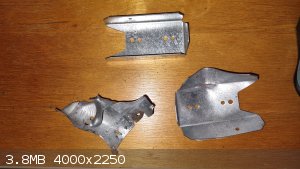
|
|
|
dettoo456
Hazard to Others
  
Posts: 242
Registered: 12-9-2021
Member Is Offline
|
|
What did you do with the UXO cap? I know the standard procedure is to wait 20 min, fire again, then wait 20min and set it off with a reliable remote
charge but there aren’t many instances of a well-documented situation like that.
Also, I’d assume those pieces of metal should’ve been decimated with the close to & above 1g quantities of EM. Though, the only real point of
the cap is to get a secondary initiated, and that can be done with <800mg PETN in some cases.
|
|
|
ManyInterests
National Hazard
   
Posts: 930
Registered: 19-5-2019
Member Is Offline
|
|
I did wait, and I probably gave it more than 20 minutes, too. I moved it aside to detonate the others. The thing did not go off.
I should have written why I suspected the other cap didn't go off (it is with me right now) is that I was trying to see how much I can cram into it. I
used some of my poor quality NHN (it doesn't burn very fast) and did with the sodium chlorate addition and soap. As I was plugging in the e-match, it
didn't go all the way in like in my other caps. I still put in some epoxy and due to the looseness of it, I think there was a layer of epoxy between
the e-match and the epoxy that blocked ignition.
I made a 2nd one like it, but I did not try to set it off. The next time I go out. I will tape them together with another cap I know will go off and
have them all pop together.
| Quote: |
Also, I’d assume those pieces of metal should’ve been decimated with the close to & above 1g quantities of EM. Though, the only real point of
the cap is to get a secondary initiated, and that can be done with <800mg PETN in some cases. |
That is true. This test was to simply get to make sure that my caps function as intended and can do the job. I had difficulties with other caps in the
past, but that was due to them using plastic pen bodies. The reason why there wasn't more damage to the plates is because there was plenty of space
for the metal to be forced into (snow isn't exactly hard). If I placed the plates on a solid surface there would probably be a lot more visible damage
to the plates. Even the pure NHN one (NHN-chlorate mixture) was quite powerful and I think it'll set most anything off. The one with the 1.1g ETN
charge is extremely powerful.
At this point I am confident with these and the next time I go out I will bring a small ammonium picrate charge (in a thick cardboard tube) to try a
1.1g of NHN-sodium chlorate charge and se if it'll detonate. I made ammonium picrate specifically for this test: It is the most insensitive secondary
outside of ANFO.
|
|
|
Microtek
National Hazard
   
Posts: 869
Registered: 23-9-2002
Member Is Offline
Mood: No Mood
|
|
If the caps detonate fully, it won't matter what it is resting on. Like shooting an apple hanging on a string, the event is much too fast for the
target to move anywhere before it is penetrated. I think you should save your picrate for when your caps work better. Also, I think ammonium picrate
is generally used with a booster, so you should a least use a very beefy detonator.
|
|
|
ManyInterests
National Hazard
   
Posts: 930
Registered: 19-5-2019
Member Is Offline
|
|
Quote: Originally posted by Microtek  | | If the caps detonate fully, it won't matter what it is resting on. Like shooting an apple hanging on a string, the event is much too fast for the
target to move anywhere before it is penetrated. I think you should save your picrate for when your caps work better. Also, I think ammonium picrate
is generally used with a booster, so you should a least use a very beefy detonator. |
I can make another large detonator?
The charge I intend to set off is around 30g charge. I have more to try at later dates if my cap doesn't work.
The NHN composition that I used was made following this thread: https://www.sciencemadness.org/whisper/viewthread.php?tid=15...
he did say that 1g loading was able to set off AN based secondaries. If the AN he is referring to is ammonium nitrate it should be sufficient.
Is the 1g detonator not good enough in your opinion? I posted more pics of the plate.
[Edited on 26-2-2024 by ManyInterests]
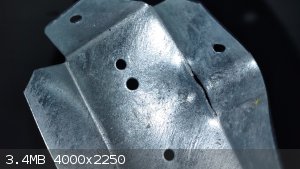 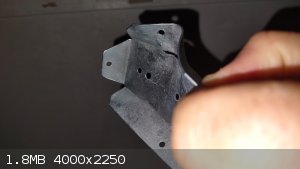 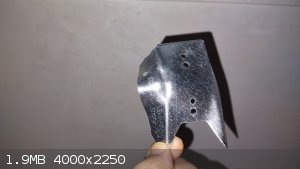
|
|
|
Laboratory of Liptakov
International Hazard
    
Posts: 1386
Registered: 2-9-2014
Location: Technion Haifa
Member Is Online
Mood: old jew
|
|
How were thickness of plate? 1,5 or 2 mm? Anyway, the your hole is weak. 1g ETN must causes circle hole minimal 10 mm. On second photo is plate 2 mm
and 0.4 g ETN.
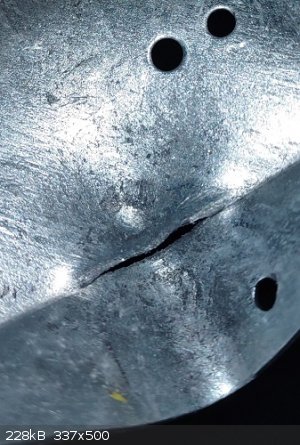 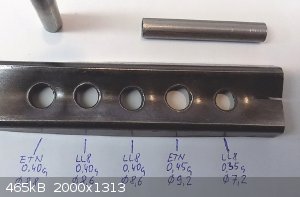
Development of primarily - secondary substances CHP (2015) Lithex (2022) Brightelite (2023) Nitrocelite and KC primer (2024)
|
|
|
| Pages:
1
..
10
11
12
13
14
..
18 |